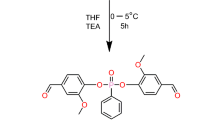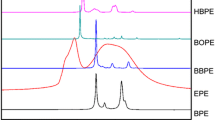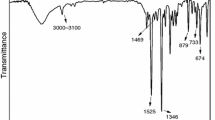Abstract
A phosphine oxide-containing bio-based curing agent was synthesized by addition reaction between furan derivatives and diphenylphosphine oxide. The molecular structure of the as-prepared bio-based curing agent was confirmed by Fourier transform infrared spectroscopy and nuclear magnetic resonance spectroscopy. Dynamic mechanical analysis results indicated that with the increase of bio-based curing agent content, the glass transition temperature of epoxy/bio-based curing agent composites decreased, which was related to the steric effect of diphenylphosphine oxide species that possibly hinder the curing reaction as well as the reduction in the cross-linking density by mono-functional N-H. By the addition of 7.5 wt-% bio-based curing agent, the resulting epoxy composite achieved UL-94 V-0 rating, in addition to limiting oxygen index of 32.0 vol-%. With the increase of content for the bio-based curing agent, the peak of heat release rate and total heat release of the composites gradually decreased. The bio-based curing agent promoted the carbonization of the epoxy matrix, leading to higher char yield with good thermal resistance. The high-quality char layer served as an effective barrier to retard the diffusion of decomposition volatiles and oxygen between molten polymers and the flame. This study provides a renewable strategy for fabricating flame retardant and transparent epoxy thermoset.

Similar content being viewed by others
References
Guo W W, Nie S, Kalali E N, Wang X, Wang W, Cai W, Song L, Hu Y. Construction of SiO2@UiO-66 core shell microarchitectures through covalent linkage as flame retardant and smoke suppressant for epoxy resins. Composites. Part B, Engineering, 2019, 176: 107261
Guo W W, Wang X, Gangireddy C S R, Wang J L, Pan Y, Xing W, Song L, Hu Y. Cardanol derived benzoxazine in combination with boron-doped graphene toward simultaneously improved toughening and flame retardant epoxy composites. Composites. Part A, Applied Science and Manufacturing, 2019, 116: 13–23
Wang X, Hu Y, Song L, Xing W Y, Lu H D, Lv P, Jie G X. Flame retardancy and thermal degradation mechanism of epoxy resin composites based on a DOPO substituted organophosphorus oligomer. Polymer, 2010, 51(11): 2435–2445
Kong Q H, Sun Y L, Zhang C J, Guan H M, Zhang J H, Wang D Y, Zhang F. Ultrathin iron phenyl phosphonate nanosheets with appropriate thermal stability for improving fire safety in epoxy. Composites Science and Technology, 2019, 182: 107748
Kong Q H, Wu T, Zhang J H, Wang D Y. Simultaneously improving flame retardancy and dynamic mechanical properties of epoxy resin nanocomposites through layered copper phenylphosphate. Composites Science and Technology, 2018, 154: 136–144
Horold S, Erftstadt D E. Flame-retarding thermosetting compositions. US Patent, 6420459 B1, 2002-07-16
Perret B, Schartel B, Stoss K, Ciesielski M, Diederichs J, Doring M, Kramer J, Altstadt V. Novel DOPO-based flame retardants in high-performance carbon fibre epoxy composites for aviation. European Polymer Journal, 2011, 47(5): 1081–1089
Cai W, Feng X, Wang B, Hu W, Yuan B, Hong N, Hu Y. A novel strategy to simultaneously electrochemically prepare and functionalize graphene with a multifunctional flame retardant. Chemical Engineering Journal, 2017, 316: 514–524
Cai W, Wang J, Pan Y, Guo W, Mu X, Feng X, Yuan B, Wang X, Hu Y. Mussel-inspired functionalization of electrochemically exfoliated graphene: based on self-polymerization of dopamine and its suppression effect on the fire hazards and smoke toxicity of thermoplastic polyurethane. Journal of Hazardous Materials, 2018, 352: 57–69
Cai W, Cai T, He L, Chu F, Mu X, Han L, Hu Y, Wang B, Hu W. Natural antioxidant functionalization for fabricating ambient-stable black phosphorus nanosheets toward enhancing flame retardancy and toxic gases suppression of polyurethane. Journal of Hazardous Materials, 2020, 387: 121971
Cai W, Li Z, Mu X, He L, Zhou X, Guo W, Song L, Hu Y. Barrier function of graphene for suppressing the smoke toxicity of polymer/black phosphorous nanocomposites with mechanism change. Journal of Hazardous Materials, 2021, 404: 124106
Shi Y Q, Liu C, Duan Z P, Yu B, Liu M H, Song P A. Interface engineering of MXene towards super-tough and strong polymer nanocomposites with high ductility and excellent fire safety. Chemical Engineering Journal, 2020, 399: 125829
Shi Y Q, Yu B, Duan L J, Gui Z, Wang B B, Hu Y, Yuen, Rechard K K. Graphitic carbon nitride/phosphorus-rich aluminum phosphinates hybrids as smoke suppressants and flame retardants for polystyrene. Journal of Hazardous Materials, 2017, 332: 87–96
Zhou K Q, Tang G, Gao R, Jiang S D. In situ growth of 0D silica nanospheres on 2D molybdenum disulfide nanosheets: towards reducing fire hazards of epoxy resin. Journal of Hazardous Materials, 2018, 344: 1078–1089
Qiu S L, Zou B, Zhang T, Ren X Y, Yu B, Zhou Y F, Kan Y C, Hu Y. Integrated effect of NH2-functionalized/triazine based covalent organic framework black phosphorus on reducing fire hazards of epoxy nanocomposites. Chemical Engineering Journal, 2020, 401: 126058
Xu W Z, Yan H Y, Wang G S, Qin Z Q, Fan L J, Yang Y X. A silicacoated metal-organic framework/graphite-carbon nitride hybrid for improved fire safety of epoxy resins. Materials Chemistry and Physics, 2021, 258: 123810
Hergenrother P M, Thompson C M, Smith J G Jr, Connell J W, Hinkley J A, Lyon R E, Moulton R. Flame retardant aircraft epoxy resins containing phosphorus. Polymer, 2005, 46(14): 5012–5024
Mercado L A, Galia M, Reina J A. Silicon-containing flame retardant epoxy resins: synthesis, characterization and properties. Polymer Degradation & Stability, 2006, 91(11): 2588–2594
Hsiue G H, Wang W J, Chang F C. Synthesis, characterization, thermal and flame-retardant properties of silicon-based epoxy resins. Journal of Applied Polymer Science, 1999, 73(7): 1231–1238
Levchik S, Piotrowski A, Weil E, Yao Q. New developments in flame retardancy of epoxy resins. Polymer Degradation & Stability, 2005, 88(1): 57–62
Sponton M, Ronda J C, Galia M, Cadiz V. Flame retardant epoxy resins based on diglycidyl ether of (2,5-dihydroxyphenyl)diphenyl phosphine oxide. Journal of Polymer Science. Part A, Polymer Chemistry, 2007, 45(11): 2142–2151
Zhao J, Dong X, Huang S, Tian X, Song L, Yu Q, Wang Z. Performance comparison of flame retardant epoxy resins modified by DPO-PHE and DOPO-PHE. Polymer Degradation & Stability, 2018, 156: 89–99
Tian X, Yin Q, Wang Z. Synthesis of diphenylphosphine oxide derivative and its flame retardant application in epoxy resin. Journal of Photopolymer Science and Technology, 2020, 32(6): 769–778
Yang D Q, Dong L M, Hou X D, Zheng W K, Xiao J, Xu J Z, Ma H Y. Synthesis of bio-based poly (cyclotriphosphazene-resveratrol) microspheres acting as both flame retardant and reinforcing agent to epoxy resin. Polymers for Advanced Technologies, 2020, 31(1): 135–145
Zhang J H, Mi X Q, Chen S Y, Xu Z J, Zhang D H, Miao M H, Wang J S. A bio-based hyperbranched flame retardant for epoxy resins. Chemical Engineering Journal, 2020, 381: 122719
Ma C, Li J. Synthesis of an organophosphorus flame retardant derived from daidzein and its application in epoxy resin. Composites. Part B, Engineering, 2019, 178: 107471
Xie W Q, Huang S W, Tang D L, Liu S M, Zhao J Q. Biomass-derived Schiff base compound enabled fire-safe epoxy thermoset with excellent mechanical Properties and high glass transition temperature. Chemical Engineering Journal, 2020, 394: 123667
Dai J Y, Teng N, Liu J K, Feng J X, Zhu J, Liu X Q. Synthesis of bio-based fire-resistant epoxy without addition of flame retardant elements. Composites. Part B, Engineering, 2019, 179: 107523
Tian Y Z, Wang Q, Hu Y J, Sun H, Cui Z C, Kou L L, Cheng J, Zhang J Y. Preparation and shape memory properties of rigidflexible integrated epoxy resins via tunable micro-phase separation structures. Polymer, 2019, 178: 121592
Chi Z Y, Guo Z W, Xu Z C, Zhang M J, Li M, Shang L, Ao Y H. A DOPO-based phosphorus-nitrogen flame retardant bio-based epoxy resin from diphenolic acid: synthesis, flame-retardant behavior and mechanism. Polymer Degradation & Stability, 2020, 176: 109151
Tang G, Wang X, Zhang R, Yang W, Hu Y, Song L, Gong X L. Facile synthesis of lanthanum hypophosphite and its application in glass-fiber reinforced polyamide 6 as a novel flame retardant. Composites. Part A, Applied Science and Manufacturing, 2013, 54: 1–9
Wang X, Song L, Yang H Y, Xing W Y, Kandola B, Hu Y. Simultaneous reduction and surface functionalization of graphene oxide with POSS for reducing fire hazards in epoxy composites. Journal of Materials Chemistry, 2012, 22(41): 22037–22043
Tang G, Liu X L, Zhou L, Zhang P, Deng D, Jiang H H. Steel slag waste combined with melamine pyrophosphate as a flame retardant for rigid polyurethane foams. Advanced Powder Technology, 2020, 31(1): 279–286
Yan Y, Huang P, Zhang H P. Preparation and characterization of novel carbon molecular sieve membrane/PSSF composite by pyrolysis method for toluene adsorption. Frontiers of Chemical Science and Engineering, 2020, 13(4): 772–783
Guo W W, Zhao Y Y, Wang X, Cai W, Wang J L, Song L, Hu Y. Multifunctional epoxy composites with highly flame retardant and effective electromagnetic interference shielding performances. Composites. Part B, Engineering, 2020, 192: 107990
Guo W W, Wang X, Huang J L, Zhou Y F, Cai W, Wang J L, Song L, Hu Y. Construction of durable flame-retardant and robust superhydrophobic coatings on cotton fabrics for water-oil separation application. Chemical Engineering Journal, 2020, 398: 125661
Wang X, Zhou S, Xing W Y, Yu B, Feng X M, Song L, Hu Y. Self-assembly of Ni-Fe layered double hydroxide/graphene hybrids for reducing fire hazard in epoxy composites. Journal of Materials Chemistry. A, Materials for Energy and Sustainability, 2013, 1(13): 4383–4390
Tang G, Zhou L, Zhang P, Han Z Q, Chen D P, Liu X Y, Zhou Z J. Effect of aluminum diethylphosphinate on flame retardant and thermal properties of rigid polyurethane foam composites. Journal of Thermal Analysis and Calorimetry, 2020, 142(2): 129–137
Zhu Z M, Wang L X, Dong L P. Influence of a novel P/N-containing oligomer on flame retardancy and thermal degradation of intumescent flame-retardant epoxy resin. Polymer Degradation & Stability, 2019, 162: 129–137
Acknowledgements
This research was supported by the National Natural Science Fundation of China (Grant Nos. 51978002 and 51403004), the Jiaxing Science and Technology Project (Grant No. 2020AD10020) and Postdoctoral Science Foundation of China (Grant No. 2017M610399).
Author information
Authors and Affiliations
Corresponding authors
Electronic Supplementary Material
Rights and permissions
About this article
Cite this article
Tang, G., Zhao, R., Deng, D. et al. Self-extinguishing and transparent epoxy resin modified by a phosphine oxide-containing bio-based derivative. Front. Chem. Sci. Eng. 15, 1269–1280 (2021). https://doi.org/10.1007/s11705-021-2042-1
Received:
Accepted:
Published:
Issue Date:
DOI: https://doi.org/10.1007/s11705-021-2042-1




